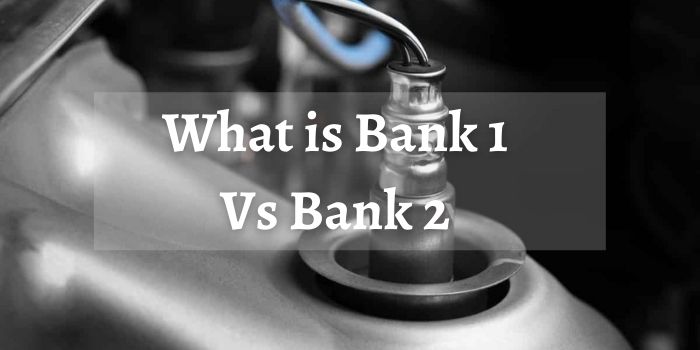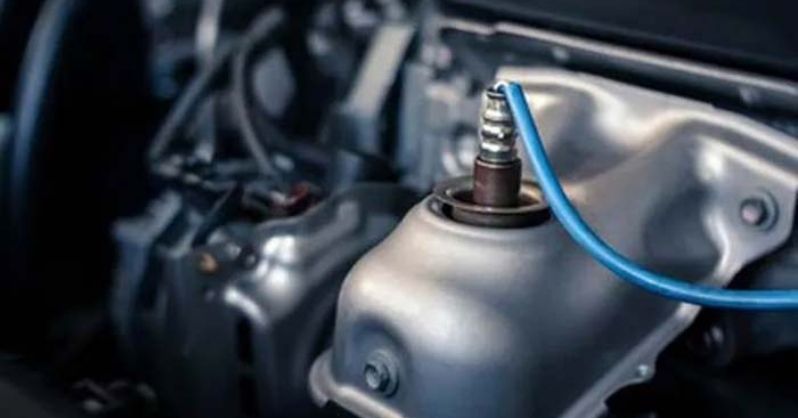Before you start working on your car, it’s important to understand which bank is the issue here. Especially when identifying sensors, to avoid making an error and repairing the wrong sensor.
So, the question in focus here is, what is bank 1 vs bank 2?
Mostly, bank 1 and bank 2 refer to the engine’s sides. However, it doesn’t simply specify the side as right or left. Numerous vehicles have their bank 1 and bank 2 in several places. Nevertheless, one thing remains the same everywhere: bank 1 is often suggested as the “location” where the first cylinder can be found.
In this article, I’ll walk you through how to accurately recognize bank 1 and bank 2 on any model of vehicle. We’ll also figure out where the O2 sensors are. Let’s get going!

How to Know Bank 1 and Bank 2?
You may have learned that bank 1 is on the opposite of the passengers’ side, meaning the driver’s corner. You might’ve also learned that it could be somewhere near the first cylinder, which is near the front. However, it’s incorrect because all the car models aren’t the same.
Location of Blank 1
You’ll know which side is bank 2 the moment you find bank 1. As we’ve already learned bank 1 is placed at the side of cylinder 1. As a result, all that is required to determine the location of bank 1 is to determine the location of cylinder 1.
There are a number of different ways to perform this; we’ll go over the most simple ones below.
Search the Engine Room
Checking the crankcase or your car’s ignition wiring is the simplest method. Nonetheless, a mark on the crankcase or ignition cables doesn’t appear on every car.
If the ignition wires are marked with numbers, ensure that they haven’t been meddled with before replacing them. Because there’s a chance, they were relocated and came back in the wrong sequence.
Enquire with Someone Who Knows
If you are looking for an easier method, then you might want to follow this. You can consult a credible dealership, a technician who is familiar with your vehicle, research in related online groups, or look in your car’s service manual.
Check to see if the information they provide is correct for your car’s category and engine. If you’re looking for answers in an automobile forum, be sure they’re thorough. Suppose someone from the United Kingdom has informed you that bank 1 is placed at the side of the driver. However, this isn’t correct if you’re from a South-Asian country because, in the United Kingdom, people drive the car on the left side.
Invest in an OBD2 Scanner
You see, an OBD2 scanner is useful in many situations along with this one. Now, you just need to do one thing carefully, which is to follow the following three easy stages to find the right bank.
- Connect your OBD2 scanner and clear all of the error codes such as $07e8 code
- Remove one of the O2 sensors.
- The code that appears as a result of the disconnected O2 sensor will also indicate which bank is involved.
How Many O2 Sensors Are there?

The number of O2 sensors in a vehicle varies, although all cars contain a minimum of two. First, O2 sensors are separated into two groups: bank 1 and bank 2. Then again both of these are allotted into two groups based on the number of sensors, which is either 1 or 2.
As a result, many people face difficulty differentiating between bank 1 and bank 2 sensors. Therefore, they often replace the incorrect sensors, wasting money as well as time. However, sensor 1 is in front of the catalytic converter, whereas sensor 2 is behind it.
While scanning a diagnostic error code (DTC), follow the guidelines above to discover the malfunctioning O2 sensor by scanning the code and locating the proper bank. Sometimes, the scanner may display engine error code 7ea. But it’s not a problem as you just have to feed the device more info.
What do Sensor 1 and Sensor 2 Mean?
The number of the sensor should indicate the location of the O2 sensor or the exhaust temperature sensor in the exhaust system. As a general rule, you will find the first sensor near the engine, while the second is typically located towards the back end of the exhaust system.
In general, when it comes to O2 sensors:
- Sensor 1 is placed in front of the Catalytic Converter.
- Sensor 2 is placed in the rear of the catalytic converter.
In a system with multiple sensors, such as in diesel engines, the sensor numbers may be arranged in a sequence from 1-2-3-4 and so on. Typically, the first sensor is closest to the engine, while the last sensor is at the tail end of the exhaust system. This
There is only one bank in a four-cylinder or inline six-cylinder engine. As a result, all of the oxygen sensors will be on bank 1. The front sensor is specified as “bank 1 sensor 1,” whereas the rear sensor is specified as “bank 1 sensor 2.”
If your car’s cylinder firing order is 1,2,3,5,7, and so on, then the front and rear sensors are cited in a V6 and V8 engine as bank 1 sensor 1 and sensor 2.
Which One is the Upstream and Downstream O2 Sensors?
Every vehicle contains a minimum of an upstream sensor which is sensor 1, and a downstream sensor which is sensor 2. Here, the amount of pollutants is measured by the upstream sensor in the engine’s exhaust. And it communicates that data to the ECU, which determines the ratio of the air-fuel on the fly.
And the amount of pollutants that pass the catalytic converter is detected by the downstream sensor. The ECU compares the data from both sensors. After that, the ECU sets a catalyst ineffective code if the values from the two sensors are quite the same.
According to a DTC that states, the Bank 1 sensor 2 sensor is positioned on the cylinder 1 side behind the catalytic converter.
Each DTC that scans “Bank 1 sensor 1,” on the other hand, indicates that the O2 sensor is situated in front of the catalytic converter, at the side of cylinder 1.
If we look from this same view then “Bank 2 sensor 2” would suggest that the oxygen sensor is positioned on the rear side of the catalytic converter, on the other side of bank 1.
All in all, the bank helps us to differentiate between the positions of the sensors on bank and bank 2. Whereas the number of the sensor indicates whether the oxygen sensor is in front of the catalytic or on the back of it or specify sensor 1 and sensor 2 accordingly. Remember that the side of cylinder 1 determines the position of bank 1.
What is the Voltage of the Bank 1 Sensor 2?
The idea behind every oxygen sensor isn’t different from each other. You see, the voltage will fluctuate from 0.1-1 volt based on the current situation.
Sensor 2 should provide more consistent readings because it is located at the backside of the catalytic converter. The voltage must be about 0.45 volts when it isn’t functioning or while running at a compatible rate.
What Are the Signs And Symptoms Of A Faulty Bank 1 Sensor 2?
If not changed promptly, malfunctioned O2 sensors can create a lot of problems. As a result, as soon as you suspect the sensor is malfunctioning, identify it, have it tested, and then repair it.
The following are some examples of regular symptoms:
Rough Idle of the Engine
The ECU will receive inaccurate information from a defective oxygen sensor. This might cause the engine to receive extra fuel than it needs, leading it to stall. As a result, the engine will have a harsh idle.
Emissions Have Increased
A faulty oxygen sensor won’t be able to keep exhaust emissions under control, resulting in higher emissions. The engine’s rich/lean condition causes inflated emissions.
Gas Mileage is Low
A defective oxygen sensor can reduce an automobile’s gas mileage. Because of the malfunctioning sensor, the ECU will send an incorrect amount of gasoline to the engine, causing lower fuel mileage.
Misfiring Engine
The combustion in the cylinders of the engine is altered when the level of air-fuel mix given to the engine is not the best. This might result in the engine misfire. You may notice it normally if your engine idles or speeds. Engine reluctance during acceleration might potentially be a sign of a faulty oxygen sensor.
Here are some of the trouble codes you might find if the bank 1 sensor 2 is malfunctioning. P0036, P0037, P0038, P0041, P0054, P0136, P0137, P0138, P0139, P0140, P0141.
Is It Difficult To Replace Bank 1 Sensor 2?
No, it’s not! You just need to grab the correct tools and then you can easily replace the bank 1 sensor 2. So, you’ll need the following tools-
- Jack
- An oxygen sensor socket
- Jack stands
- Penetrating oil as the O2 sensors might wear away.
However, remember that the current alternative oxygen sensors need to be the exact type and have the exact number of cables as the actual ones placed in the vehicle. Otherwise, you’ll have trouble with that as well.
If any of the oxygen sensors fails for any reason, for example, breakdown or wear, the computer will be unable to generate the correct configuration of oxygen and gasoline mixture.
Conclusion
Hope I was successful to give you a clear idea of Bank 1 Vs Bank 2. A variety of OBD-II problem codes cite Bank 1 or Bank 2. So, I’ve attempted to resolve a discrepancy between Bank 1 and Bank 2 through this writing.
Because it’s incorrect to just claim that cylinder 1 is always on the side of the driver’s or the other way around. Even on vehicles with a diagonally placed engine, bank 1 refers to the side of cylinder 1 that is downstream in the engine.
Related Posts:
All You Need To Know About P0303 Volkswagen Issue
All About P0299 Code Volkswagen
P0455 Volkswagen: What Is It & How to Fix It?